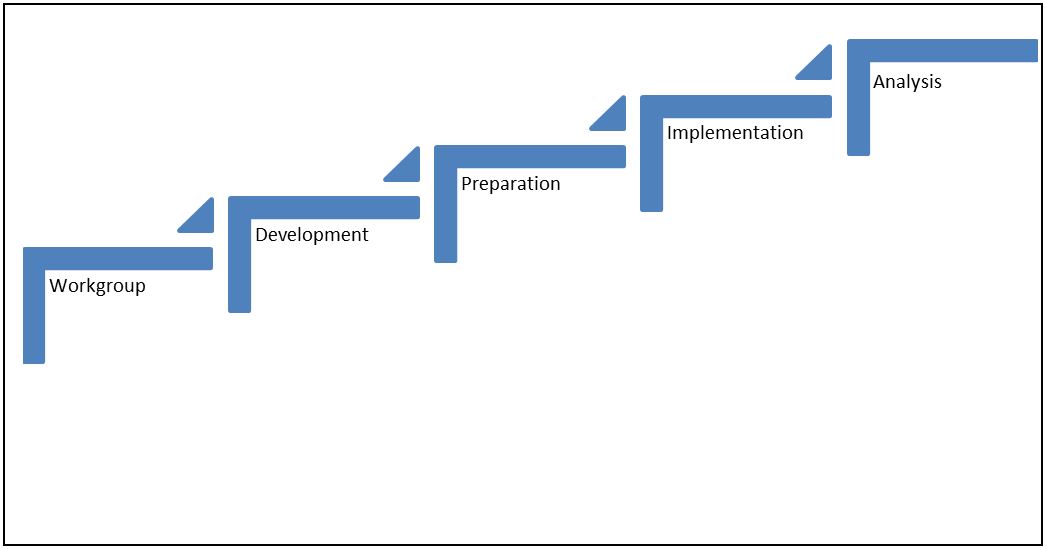The ICAO Secretariat has assembled a team of experts to support States in the smooth, timely and harmonized implementation of the SID/STAR provisions. The ICAO SID STAR Implementation Support Team (ISSIST) has surveyed several Member States to identify tools and processes that have been effective in managing the challenge of implementing the SID/STAR provisions. The SID/STAR Toolkit is distilled from the learning experiences gathered from Member States and sample documents from various civil aviation authorities (CAAs).
The methodology employed by States to implement the ICAO SID/STAR procedures typically involved the following five steps:

Assembly of a Workgroup
States implementing the ICAO SID/STAR provisions generally convene a workgroup that is responsible for accomplishing the required implementation activities. In some instances, the workgroup, as part of a holistic review of airspace infrastructure, also redesigned SID and STAR procedures to better accommodate modern airspace management techniques (e.g. CCO/CDO), thereby improving overall performance and securing the benefits of the ICAO SID/STAR provisions.
The workgroup should be comprised of the wide spectrum of stakeholders affected by the change(s). The membership of the group includes inter alia:
- a facilitator,
- air traffic control personnel,
- aircraft operators
- pilots,
- subject matter experts, such as Procedural Designers.
The processes of the group should be structured to enable the maximum participation of its members.
During the initial meetings of the team, the scope of discussions should encompass the following:
- Mission statement of the project
- Objectives to be achieved
- Decision-making processes
- Resource requirements
- Project deliverables, timelines, risks, schedules of meetings and deliverables
Development of Implementation Plan
The second step involves the group developing a forwarding looking plan which ensures that the ICAO SID/STAR provisions are smoothly implemented (perhaps within the scope of a wider airspace project) and that initiatives are created to mitigate risks associated with their adoption. For Safety Management System resources please go to: https://www.icao.int/safety/SafetyManagement/Pages/default.aspx
Member States and the representatives of ICAO's industry partners (including IATA, IBAC, IFALPA, IFATCA and CANSO) concur that if accomplished on a regional basis, the benefits from the implementation of the provisions would be enhanced. The most significant gain from a region-wide implementation is that airspace users benefit from a seamless system that is harmonized through utilizing common ICAO standard phraseology. The end result is improved compliance and lower workload for controllers and flight crews alike.
For regional implementation efforts, States should consider engaging regional resources like PIRGS, RASGs to help with coordination and planning. More information can be found at:
https://www.icao.int/safety/Implementation/Lists/RASGSPIRGS/AllItems.aspx
Pre-Implementation Preparation
The third step of the process involves preparation for the implementation of the provisions through the execution of workgroup specified initiatives that mitigate risks associated with adopting the procedures. During this phase, activities such as training of air traffic controllers, flight crews and dispatchers are accomplished. One State convened a separate "phraseology working group" that met monthly for a six-month period and developed a dedicated phraseology manual which was provided to controllers and used in parallel with national and local training.
Implementation
During the implementation stage, States implementing the ICAO SID/STAR provisions have highlighted the importance of ensuring consistent communication and engagement with air traffic control personnel and airspace users impacted by the change. Some States provide specially trained individuals who serve as on-the-spot focal points for control personnel and serve as information conduits to airspace users where the need arises.
While there have been numerous successful implementations, it is important to understand that even in the of best cases; in spite of the hard work, attention to detail and mitigations in advance by the implementation workgroup, introduction of change is difficult and in most cases requires an adjustment period for the people that are affected. The support that is provided during implementation, and the responsiveness of such support in answering to the needs of people undergoing the changes, is essential in assisting the transition to the use of new provisions (i.e. phraseology).
Post Implementation Analysis
As part of safety management, and to measure the success of the implementation in achieving its targets, an analysis of data collected from the "live" use of the provisions needs to be conducted post- implementation. To gather data, States should, using the established system for reporting and documenting irregularities, adjust for the additional reports arising from this implementation. Air traffic controllers and flight crews will be the main contributors for such information, which should be compiled and interpreted by the workgroup and used to develop initiatives which further refine the procedures, or mitigates areas of safety concerns.
Implementation Resources
The following links are provided which focus on the implementation of performance based navigation (PBN) procedures. These resources may be helpful to States that are redesigning SID/STAR procedures. Additionally, some of the processes used to implement PBN procedures may also be applied to the implementatin of the ICAO SID/STAR provisions.
Useful Links
EUROCONTROL PBN Support
FAA PBN Procedures
